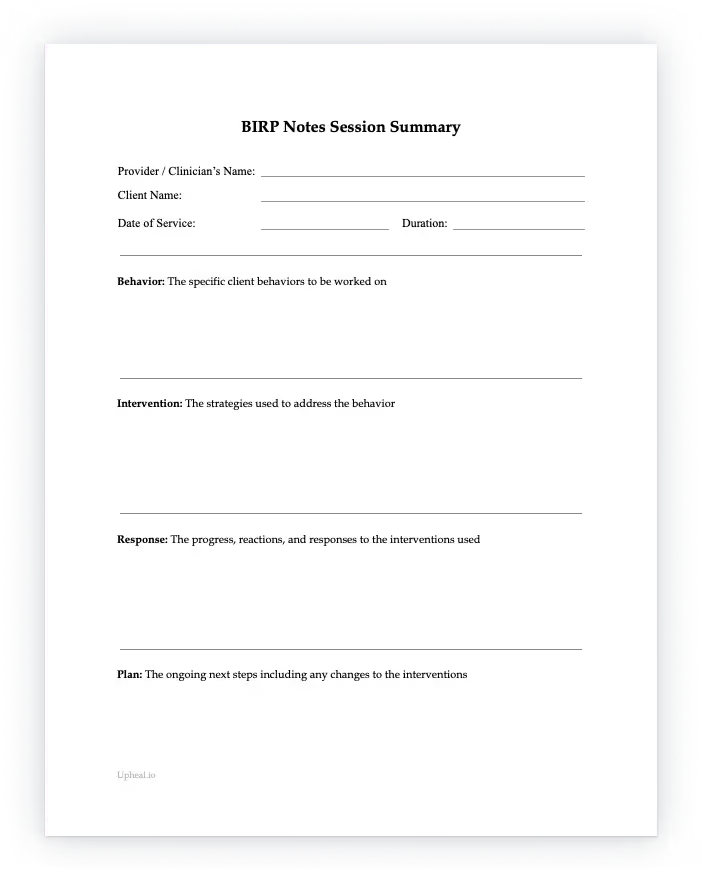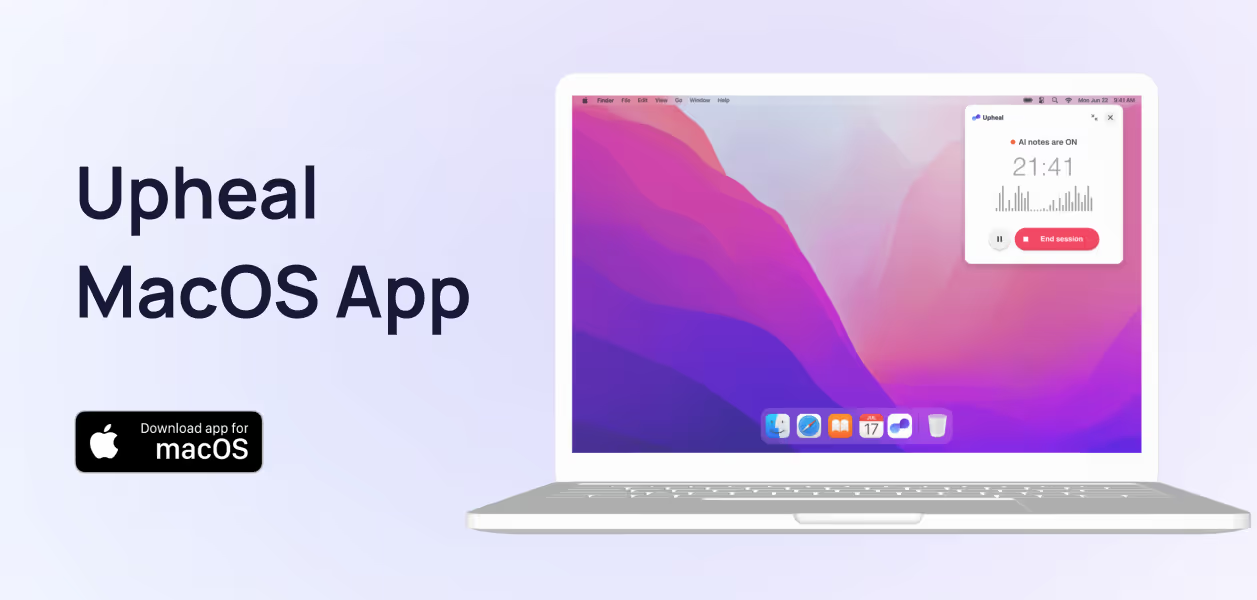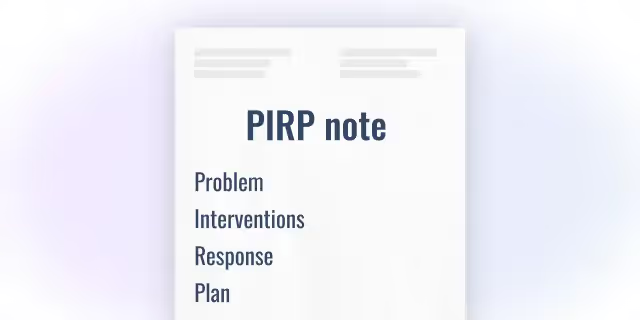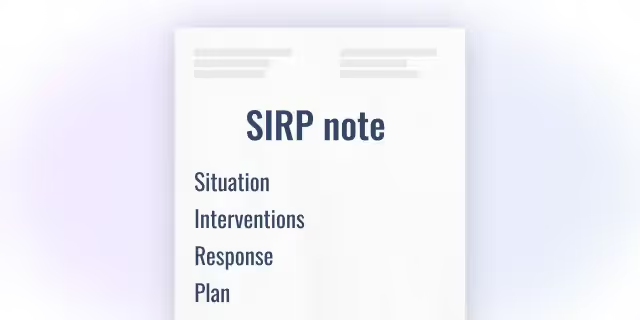How to write BIRP notes – a real-life example
Many therapists are not prepared for the amount of clinical documentation they will have to do on top of their demanding day job.
Each session must be documented for legal, insurance, and therapy purposes to protect both client and therapist. However, it’s not always clear which notes to use and when. That’s why we’ve already written about all the progress notes and went into detail on SOAP and DAP notes.
The BIRP therapy note, despite its rather unfortunate acronym, is actually a very elegant and succinct way to track client progress in response to the treatments a therapist uses in-session.
BIRP notes are focused on client behavior and that can make them useful for specific cases and treatment modalities.
In this article, we’ll explore what BIRP notes are, when to use them, and how to write them. We’ll also share a BIRP note example from our Head of Clinical Operations. Finally, we’ll provide a template that you can download for free.
Ready? Let’s get started.
What is a BIRP note?
BIRP notes are a progress note type used by mental health professionals such as psychotherapists, counselors, social workers, psychiatrists, and psychologists.
The BIRP note acronym stands for Behavior, Intervention, Response, and Plan. Each of these sections is an essential component of the mental health BIRP note that a practitioner writes when using this particular note format.
The BIRP note components:
- Behavior (B)
Description of the client’s behavior observed during the session. - Intervention (I)
Actions taken by the clinician in response to the behavior. - Response (R)
Patient's reaction to the intervention. - Plan (P)
Future treatment plan, follow-up actions, and next steps.
Writing notes in a BIRP format allows for a succinct picture of the client each session – and how they progressed (or didn’t) in reaction to specific interventions or treatment techniques selected by the therapist. In layman’s terms, using BIRP notes for mental health answers the following points using observations and interventions focused on behavior.
BIRP note example – written by a therapist
Our Head of Clinical Operations, Ted Faneuff, has picked the following scenario that’s well-suited to BIRP notes from his years in therapy practice.
The therapist will document the child's behavioral difficulty first – in this case, trouble focusing in the classroom for more than 10 minutes at a time. This will go into the Behavior section.
The therapist may then implement a token economy system for rewarding earned tokens for maintaining focus, which is an intervention and so will be documented in the Intervention section.
By the end of the week, the child's focus may have increased to 15 minutes a day. The therapist will document this in the Response section.
The therapist may also decide to continue the token system for the following week hoping to increase the time even more and this will be documented in the Plan section.
The above scenario can be turned into notes quite fast when focusing on brevity and efficiency. You can see that Ted even opted for shorter sentences and descriptions.
BIRP note template pdf
Use our free BIRP note template for your client sessions – it’s free to download.

How to write a BIRP note – a step-by-step guide
Here’s our head therapist’s step-by-step guide using the BIRP acronym. It’s a neat way to remember what you’re trying to capture in each section.
BIRP notes cheat sheet
Here’s how to remember and understand BIRP sections in 4 easy steps.
- B: What client behavior needs to be treated in this session?
- I: How did I, the therapist, intervene? What did I do about it?
- R: What was the response to that? How well did it work or not?
- P: What’s the plan going forward in the next session(s)?
Why use the BIRP template?
Unlike other progress notes, the BIRP note template focuses on behavior. If you’re a psychologist, you will have studied Behaviorism – a movement in psychology and philosophy that emphasizes the outward behavioral aspects of thought over the inward experience.
When applied to BIRP notes, we see this same focus on behavior; the therapist works on the outward expressions of a client’s state, without necessarily diving deep into a client’s experience and the assessment of their state (which is a more Freudian or psychoanalytic aspect).
- A focus on behavior – BIRP note templates are highly effective in therapy situations where the focus is on the client's behavior. The overall emphasis is on targeting specific problematic behaviors and tracking the progress made in modifying these. BIRP notes can therefore be useful for treating disorders where behavior is an important facet of the expression, such as OCD or Tourette’s.
- Fast evaluation of treatment success – When using a mental health BIRP note, there is also a large emphasis on the client's response to various interventions used by the therapist. It’s therefore a streamlined way to evaluate and change the interventions being used by the therapist.
- Less assessment more effectivity – Since treatment interventions are being evaluated constantly, as is the client’s response, BIRP notes are perfect for keeping the therapist focused on treatment rather than spending time evaluating the client deeply each session.
- Training students and new therapists – BIRP notes are also useful for studying therapist behavior and its effectiveness. Therefore, they can be very helpful for students and new therapists who may just be learning how to conduct therapy and are looking for examples of which interventions to apply and when.
- Insurance companies like BIRP notes – The focus on visible behavior and interventions, and less on the client’s experience, makes BIRP notes easier for insurance companies to process and evaluate. BIRP notes are an efficient way to keep track of client progress in a behavioral health setting and help clinicians stay on track in meeting the client’s objectives.
Common use cases for the BIRP note template
- Use case no.1
Applied Behavioral Analysis (ABA)- ABA is rooted in the science of learning and behavior. ABA is commonly used with patients on the autism spectrum to improve skills and is also used in working with clients with developmental delays. The BIRP note template, with its emphasis on client behaviors, is a perfect fit for these settings. - Use case no.2
Treating children or adolescents with behavioral disorders - When treating children or teens with problematic behaviors, the BIRP note is perfect for highlighting the progress made concerning each of the targeted behaviors. As mentioned above, OCD can fit into this category. - Use case no.3
Working with couples and families - BIRP notes are very effective for tracking communication patterns and dynamics within a couple or family. The tracking of specific behaviors regarding these communication patterns helps to quickly identify areas of improvement in a couple or family unit. - Use case no.4
Substance use or eating disorder treatment - Therapists can track triggers, cravings, or compulsions and highlight relapse prevention strategies with ease using the BIRP progress note template. - Use case no.5
The application of specific skills - Such as relaxation skills, anger management, etc. Thanks to the focus on specific behavior or skills acquisition progress tracking, the BIRP note is ideal.
Additional insights
You can write BIRP notes faster with a trustworthy automated platform like Upheal. Take a look at our AI-powered BIRP note example. A draft is created for you, allowing you to save time by simply reviewing and editing, rather than writing an entire session note from scratch.
As we covered, the BIRP note can be used in psychotherapy, psychiatry, and even group settings, but is most helpful for targeting behavioral health. The terms “behavioral health” and “mental health” are sometimes used interchangeably, but they’re not the same. Behavioral healthcare focuses on actions a person takes, hence, behavior, and why the BIRP note is so appropriate.
We recommend using the BIRP note if you work with behavioral therapy techniques, such as CBT, DBT, and ACT. CBT focuses on how your thoughts influence your mood and your actions, DBT is most commonly used for treating conditions with high emotional dysregulation and relationship distress, and ACT is a therapy that uses mindfulness techniques to help people change their behaviors and mindset. Its goal is to help people learn acceptance and flexibility.
By using BIRP notes for clinical documentation, therapists can save time and more efficiently teach clients new ways to manage their thoughts and emotional responses by developing healthier behaviors in response to their usual challenges.
This can help break addictions, treat disordered eating, navigate difficult relationships, change destructive stress responses, and build healthier coping mechanisms for better overall health.
Concluding thoughts
Now that you know all about the BIRP note, you can use it when and if you come across some of the cases and situations described above.
As we explored, the BIRP note is the perfect choice for treating behavioral symptoms and disorders, when you want to be treatment and intervention focused, and don’t need or want to spend as much time on the client’s internal state and assessment.
Of course, each clinician is free to use whatever progress note style they prefer. We just wanted to outline the use cases for all progress note types so that mental health professionals can become familiar with the benefits and limits of each, and the different ways that these can add to their admin routine and their therapeutic care.
Happy writing!














